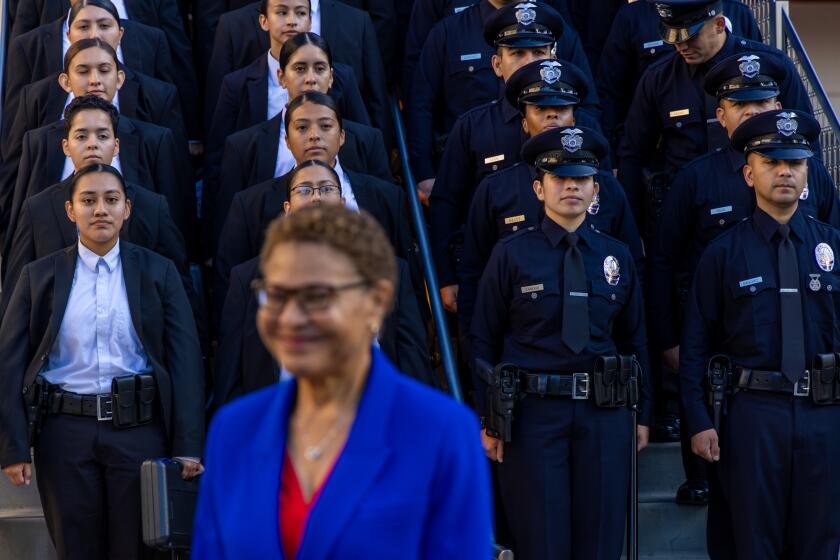‘Folks, it’s bad’: Merced sheriff warns of public safety crisis as deputy vacancies mount

- Share via
In Merced County, which stretches from the Sierra Nevada foothills west across vast acres of orchards and farmland, Sheriff Vern Warnke increasingly finds himself the only law enforcement officer available to answer a call for help.
Most recently, the department received a call from a woman regarding a domestic dispute, saying her husband had a gun. With no deputies in close range, Warnke reported to the scene, wearing his signature cowboy hat and his badge hung around his neck. He found a man pacing with a loaded gun tucked into his waistband and managed to deescalate the situation.
“We had nobody to send, and I, as the sheriff, I’m still a cop, I still love what I do,” said Warnke. “But we’re at that point when the sheriff and administration are having to take calls.”
Warnke has worked for the Merced sheriff’s office for 45 years and has been sheriff for the last decade. So it’s with heavy heart, he said, that he’s watched deputy vacancies climb to the point where he believes residents are at risk. In February, Warnke posted a video that amounted to a plea for help, warning residents that the staffing shortage was now so severe calls for service could go unheeded.
“I’m fighting for the sheriff’s office’s life right now,” Warnke says in the video. “That means I’m fighting for your public safety. So folks, it’s bad.”
The office typically has 100 deputies who handle patrol duties, but 20 of those spots are vacant. Of the 108 spots designated for custodial deputies, who work at correctional facilities, 23 are vacant. The investigative unit, budgeted as an 18-person team, is down to eight. And dispatch has four vacancies in a staff of 13.
Warnke said the vacancies have mounted in recent months and his pleas to the county Board of Supervisors to increase his budget and give him control over how funds are allocated have gone unheeded.
At this point, just four deputies patrol the county’s nearly 2,000 square miles during daytime shifts. A lieutenant and two sergeants are covering dispatch shifts. If someone calls in sick, colleagues are asked to work beyond their 12-hour shifts. One dispatcher clocked more than 700 hours of overtime over the course of a year.
“Our correctional bureaus are understaffed and overworked. Our patrol deputies are understaffed and overworked. Our communication center with the dispatchers — it could be to the point when you dial 911, we have nobody who can answer it,” Warnke said in the video. “And that’s not a joke. It’s not a threat. It’s a fact.”
The struggle to fill law enforcement ranks is a challenge in many California communities, urban and rural. The number of patrol officers per 100,000 residents is at its lowest point since at least 1991, according to a January report from the Public Policy Institute of California. The steepest declines occurred during the 2007–09 Great Recession, the PPIC researchers found, and levels have not recovered.
Last year, with about one-third of its 88 sworn officer positions vacant, the city of Alameda started offering police recruits a $75,000 enlistment bonus on top of regular pay that starts at $110,000 a year. San Francisco and some East Bay cities followed suit, raising officer pay and implementing signing and retention bonuses.
The Los Angeles City Council in August approved a four-year package of raises for officers that boosted starting pay to $86,000, and offered bigger retention bonuses. But city officials said in April they are still struggling to keep up with vacancies, and would need to hire about 60 new officers a month to overcome the attrition rate.
Smaller municipalities that can’t compete with such extravagant offers have tried other methods of retention, including free gym memberships and dry-cleaning services. But rural counties, with smaller budgets to work with, are often at the losing end of the recruitment battle. In 2022, the Tehama County Sheriff’s Office suspended daytime patrol amid a staffing shortage.
Merced County, known as the gateway to Yosemite, has a larger budget than many rural counties because it encompasses both farmland and cities such as Merced, population 90,000. The county’s annual budget for public safety has grown in recent years and makes about $93.4 million available for the sheriff’s office, according to county officials.
But Warnke said it hasn’t been enough to retain deputies, who are leaving for other counties despite Merced’s $10,000 signing bonuses. Top deputies in some neighboring counties make at least $102,000, while Merced pays its top deputies $90,000.
The sheriff acknowledged that the competition for salaries and bonuses creates a “vicious cycle.” The department went through similar shortages during his first term, and deputies received a 20% raise in 2017. But here he is facing the same problem.
“The issue is that the county doesn’t seem to want to put any planning into the future. They’ll put a Band-Aid on something and think it’s gonna hold for a long time. And it doesn’t,” Warnke said.
County spokesman Mike North said the county offered the Merced County Deputy Sheriff’s Assn. an 8% raise, which the union declined. If a raise is eventually approved, North said, funding would come from cutting into other agencies.
“We are aiming to close the compensation gap between the sheriff’s office and others in the Central Valley, and our staff has already returned to the bargaining table with the remaining public safety labor groups,” he said in a statement.
Warnke’s video and the concerns he has expressed at public hearings have prompted outcry from residents, who are worried about safety. In 2022, Merced County had the highest reported homicide rate among counties in the state with more than 100,000 residents, according to the California Department of Justice.
In March, the sheriff’s office launched an online reporting system to take in nonviolent crime reports, saying it simply did not have enough deputies to respond to calls. Custody order violations, vehicle thefts and vandalism are among the crimes that can be reported online. Violent crimes can still be reported by phone. Other law enforcement agencies have also turned to online systems to free up resources.
Merced County residents Becky and Jason Tucker say they can feel the shortage.
The couple filed a report with the sheriff’s office last summer alleging that a man had committed forgery and damaged property on their farm. They said they were told the office had just one investigator who handled agriculture-related crimes. That investigator, said Becky Tucker, was needed for homicide investigations, leaving their case open for months as the suspect roamed free. He was ultimately arrested for alleged crimes in Kern County, where he is awaiting a court appearance.
“We are concerned that if something happens on our property, we will not have access to a deputy as far as response time,” she said.
The couple have since spent $6,000 on a security system.
North said 74 cents of every general fund dollar in Merced County goes toward public safety and that the board, given various regulatory requirements, has discretion over only about 11% of the $1.16 billion budget. He said the county’s goal is to “maintain a sustainable budget that doesn’t result in massive layoffs should we encounter an economic recession.”
And the sheriff’s office is not the only county department managing high vacancy rates. Marta Echevarria, a family services representative in the human services agency, said her department has 40 vacancies and the workers who remain are doing 12-hour shifts. In December, she went before county supervisors to voice her fears of becoming homeless because the costs of both her rent and health insurance were skyrocketing.
“I hear [the sheriff] and it makes me so sad,” she said, “but at the same time it makes me so angry, because I’m thinking, ‘What about the rest of us?’”
A Times review shows the LAPD’s academy is graduating about half the number of recruits needed per class to keep pace with Mayor Karen Bass’ ambitious plan to expand the department to 9,500 officers.
A report issued last year by the Bureau of Justice said that for a variety of reasons — including a tightening labor market and heightened national tensions over the role of policing — law enforcement agencies across the country face an historic crisis in recruiting and retaining qualified candidates.
Rather than get caught up in a competition for wages and bonuses — a competition rural counties won’t win — the report recommends offering incentives that appeal to a growing hunger among younger workers for a better work-life balance. The suggestions include more paid time off, increased family leave, flexible schedules and tuition reimbursements.
Warnke acknowledged that other counties, such as Fresno, offer take-home cars for deputies, while Madera offers lifetime medical benefits to those who stay more than five years and retire with the agency.
“These are some things that our county needs to grab a hold of,” he said. “They can’t do it for the entire county, but they can sure do it for the sheriff’s office, the critical agency within the county.”
More to Read
Sign up for Essential California
The most important California stories and recommendations in your inbox every morning.
You may occasionally receive promotional content from the Los Angeles Times.











